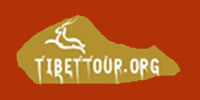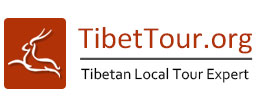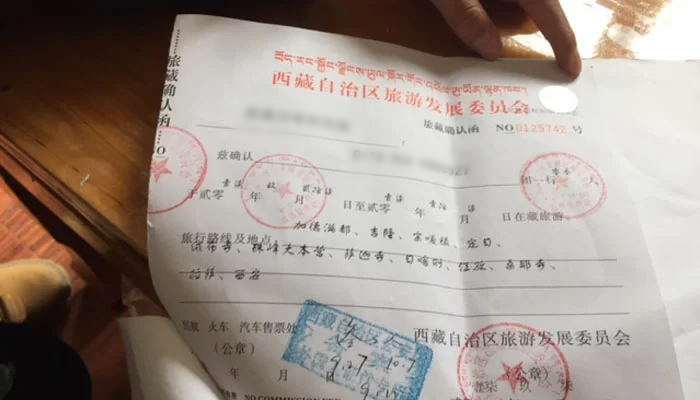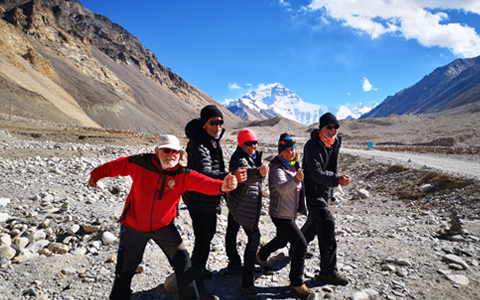Tibet has a unique culture unlike anywhere else in the world. Our religion is mainly Tibetan Buddhism, which emphasizes compassion and wisdom and influences almost every aspect of our daily lives. The language we speak is also different from that of other ethnic groups, with its own script and several dialects.
To help you make the most of your time in Tibet, we’ve put together this guide highlighting nine key aspects of Tibetan culture. Read on to deepen your understanding of our fascinating culture and get inspired for your upcoming adventure!
1. Tibetan Religion: Tibetan Buddhism as the Foundation of Tibetan Culture
Just as Catholicism is central to Vatican City, Tibetan Buddhism is the main religion in Tibet, and the soul of local culture and life. Religious buildings such as the Potala Palace and Jokhang Temple in Lhasa are world-famous Buddhist holy sites. Tibetans' daily lives are filled with religious activities such as turning prayer wheels, making pilgrimages, and hanging prayer flags.
In fact, Tibetan Buddhism wasn’t always dominant. Tibet has long been home to various religions, co-existing peacefully with each other. Tibetan Buddhism become the main religion in the 8th century AD, following the efforts of King Trisong Detsen and the arrival of Buddhist masters like Padmasambhava.
Tibetan Buddhism teaches the importance of compassion, wisdom, and the journey toward enlightenment. Therefore, most Tibetans, who practice Tibetan Buddhism, are known for their humility and kindness.
 Many local Tibetans do kora around Barkhor Street every day.
Many local Tibetans do kora around Barkhor Street every day.Join our Lhasa to Everest Base Camp tour for a smooth travel experience
2. Tibetan Language: A Unique Language Widely Spoken by Locals
The Tibetan language belongs to the Tibeto-Burman group of the Sino-Tibetan language family, and is widely spoken in the Tibet Autonomous Region, Qinghai Province, Garze Tibetan Autonomous Prefecture, etc. Some people from Bhutan, India, Nepal, and Pakistan also speak Tibetan.
The Tibetan language is mainly divided into three major dialects: Lhasa dialect, Kham dialect, and Amdo dialect. Lhasa dialect, also called Standard Tibetan, is normally used by Tibetans in the central Plateau. Kham dialect is also called the eastern Tibetan dialect, and is spoken in part of Qinghai, Sichuan, Yunnan and Qamdo Prefecture. Amdo dialect is also called the northern Tibetan dialect.
During your visit to Tibet, you can learn a few useful phrases of Tibetan language, such as “Tashi Delek” (meaning “hello” or “good luck”). This way, you can better connect with the locals, and deepen your culture immersion.
 You can learn some simple Tibetan language to better connect with locals.
You can learn some simple Tibetan language to better connect with locals.3. Tibetan Architecture: Unique Styles Featuring Magnificent Temples
Tibetan architecture is one of the most unique buildings in the world. The most representative examples are monasteries and temples, which can be found almost everywhere in Tibet.
Usually built with stone, earth and wood, Tibetan temples feature thick walls, brightly colored exteriors, and golden roofs. They are also adorned with various religious decorations like pagodas, and murals. Often sitting against rolling mountains, these temples appear even more magnificent in their natural surroundings.
When touring Tibet, you should not miss the chance to appreciate the incredible architecture of Tibetan temples. Some of the most representative Tibetan temples include Jokhang Temple and Drepung Monastery in Lhasa, as well as Tashilhunpo Monastery in Shigatse.
Besides, traditional Tibetan houses are also designed differently. Usually two floors high, the lower floor is used for livestock and storing grains, while the upper floor is for family members. A common sight of the Tibetan house is the prayer flags on the rooftop. The roof is flat so that it is easier to clean snow and conserve heat during winter months.
Tibetan housing styles vary from area to area. While two-story residential buildings are mostly found in central Tibet, tents are common to see in nomadic areas of northern Tibet. If you join our Tibet tour, you may have a chance to visit a local Tibetan family and witness their way of life firsthand.
 Jokhang Temple with its golden roof is a good symbol of Tibetan architecture.
Jokhang Temple with its golden roof is a good symbol of Tibetan architecture.4. Tibetan Arts: Rich in Thangkas, Murals and Carvings
With a history of more than 5,000 years, Tibetan art originated from rock paintings and flourished during the time of the Tubo Kingdom. Later, with the introduction of Buddhism, Tibetan arts made further progress, gaining strong ethnic and religious features. You can get a view of Tibetan art through murals, Thangkas, carvings, etc.
Tibetan murals are the true portrayal of Tibetan history, from which you can find traces of Tibetan politics, economy, and culture. The murals have abundant subjects, including historical figures and stories, religious myths, Buddhist stories, folklore, sports, entertainment and so on. The best places to appreciate Tibetan murals are Potala Palace, Jokhang Temple, etc.
Thangka is an art form of ancient Tibetan Buddhism. It is framed by colored satin and painted on silk, cloth, or paper. It mainly tells about Tibetan historical events, religious figures, and Buddhist doctrines. If you plan to visit Tibet in summer, you should not miss the Shoton Festival, when a grand Thangka unveiling ceremony will be held.
Tibetan carving is Tibetan culture in miniature. It records the past days of the Tibetan area and people's lives. The most common forms are stone and rock carvings, which you can find almost everywhere when traveling in Tibet.
 A grand Thangka unveiling ceremony is held during Shoton Festival.
A grand Thangka unveiling ceremony is held during Shoton Festival.Our Mount Everest Base Camp tour offers a chance to experience authentic Tibetan culture.
5. Tibetan Festivals: Various Celebrations Held Throughout the Year
If you want to experience Tibetan culture and get a glimpse of local Tibetan life, one great way is to attend the traditional Tibetan festivals here. Tibet hosts big and small festivals every month. Some of the most worthwhile experiences are the Tibetan New Year, Saga Dawa Festival, Shoton Festival.
Tibetan New Year, also known as Losar, is the most important annual event in Tibet. It takes place at the start of the Tibetan calendar (Feb. 28, 2025). During this time, monasteries and homes are illuminated with butter lamps, and people dress in their finest traditional clothes, visit family and friends, and worship at local monasteries.
The Saga Dawa Festival, which will fall on June 11, 2025, honors Buddha’s birth, enlightenment, and passing. Many people will make donations to monasteries during this time. It is also a time when many pilgrims start the sacred kora around Mount Kailash.
The Shoton Festival (Yogurt Festival) is a lively summer event (Aug 23, 2025), featuring music, dance and sports. Highlights include the unveiling of a giant Thangka at Drepung Monastery and picnics in Norbulingka Park, where locals gather to celebrate.
 Mount Kailash is one of the important sites to celebrate the Saga Dawa Festival.
Mount Kailash is one of the important sites to celebrate the Saga Dawa Festival.6. Tibetan Music and Dance: Closely Related to Daily Life of Locals
To many people, Tibet is an ocean of songs and dances. Dancing and singing have been extensively spread throughout Tibet since centuries ago. Tibet songs and dances are closely related to religious ceremonies, festivals and daily life.
No matter where you will go in Tibet, you will hear music. On the vast grassland, the shepherds express all their feelings through songs, that is also how they practice their voices. In monasteries, you will hear the deep chants of lamas, and in the bustling marketplaces, you can also hear cheerful songs.
Among these traditions, Tibetan opera stands out as a unique form that combines singing, dancing, and storytelling. It shares Buddhist teachings, historical events, and folk tales. During important Tibetan festivals, performers wearing colorful costumes and masks bring Tibetan opera to life in vivid performances.
Join our well-designed EBC tour for an unforgettable journey in Tibet
7. Tibetan Cuisine: Simple, Flavorful and Perfect for the High-Altitude Climate
Due to the unique plateau environment, Tibetan food has its own uniqueness. They are hearty and nourishing, designed to provide energy and warmth for locals in the cold and rugged landscape of the plateau.
Some of the popular dishes in Tibet include Tsampa, the main staple food in Tibet and made from roasted highland barley; momos (Tibetan dumplings), which can be filled with meat or vegetables; yak butter tea, the traditional drink of Tibetans made from tea leaves, yak butter, water and salt. There are also thukpa (Tibetan noodles), yak meat, yak yogurt, etc.
To enjoy authentic Tibetan food during your trip, you can visit local Tibetan restaurants, where classic dishes are served in a lively atmosphere. Tibetan tea houses are also excellent places to enjoy Tibetan food and snacks, while observing the daily life of locals.
 Tibetans entertain guests with Tsampa and butter tea.
Tibetans entertain guests with Tsampa and butter tea.8. Tibetan Clothing: Practical, Beautiful and Perfect for Staying Warm
The traditional Tibetan clothing is the robe, which is both beautiful and practical, designed to keep people warm in Tibet’s cold climate. In farming areas, robes are usually made of thin wool cloth and cotton. In nomadic areas, they are usually made of leather for winter.
Nowadays, many Tibetans also dress in modern clothing such as suits and jackets. However, when Tibetan festivals come, they would put on their most beautiful and traditional clothes. Most Tibetans have two sets of traditional dress, one as the special dress for the festival and special events like marriage and the other for daily uses.
For tourists, it is an interesting and memorable experience to wear traditional Tibetan clothing. You can take photos in beautiful Tibetan dress at famous attractions like Potala Palace Square and Barkhor Street. If you tour Tibet with us, we also offer services of Tibetan clothing rental and photography, to make your experience more special.
 Our clients took beautiful photos wearing traditional Tibetan clothing.
Our clients took beautiful photos wearing traditional Tibetan clothing.9. Tibetan Medicine: Long History with Magic Effect
As one of the world’s oldest holistic healing systems, Tibetan medicine has a history of more than 3,000 years. It combines herbal remedies, diet and spiritual practices to promote balance and well-being.
It’s widely believed in Tibetan medicine that all the suffering originates from the ignorance. The first responsibility of the Tibetan doctor is to inform the patients about the illness as well as the treatment. They also use the four diagnostic methods: looking, listening, asking and feeling the pulse, and especially attach importance to the change of the tongue and the first urination in the morning.
Many tourists visiting Tibet tend to buy some famous Tibetan medicines like saffron and cordyceps as souvenirs. If you are interested, pay attention to distinguishing between genuine and fake products.
 Tibetan Medicine has a long history of over 3000 years.
Tibetan Medicine has a long history of over 3000 years.Join our most popular Lhasa to Everest Base Camp for a culture exploration journey.
Conclusion
Tibet has developed a distinct culture, which you can explore through its architecture, language, arts, cuisine, and more. As a pioneer Tibetan tour expert, we offer a range of Tibetan culture tour packages to help you discover the essence of this holy land. Just feel free to contact us - our travel guru are always here to help you plan the perfect journey!

























 Many local Tibetans do kora around Barkhor Street every day.
Many local Tibetans do kora around Barkhor Street every day.
 You can learn some simple Tibetan language to better connect with locals.
You can learn some simple Tibetan language to better connect with locals. Jokhang Temple with its golden roof is a good symbol of Tibetan architecture.
Jokhang Temple with its golden roof is a good symbol of Tibetan architecture. A grand Thangka unveiling ceremony is held during Shoton Festival.
A grand Thangka unveiling ceremony is held during Shoton Festival. Mount Kailash is one of the important sites to celebrate the Saga Dawa Festival.
Mount Kailash is one of the important sites to celebrate the Saga Dawa Festival. Tibetans entertain guests with Tsampa and butter tea.
Tibetans entertain guests with Tsampa and butter tea. Our clients took beautiful photos wearing traditional Tibetan clothing.
Our clients took beautiful photos wearing traditional Tibetan clothing. Tibetan Medicine has a long history of over 3000 years.
Tibetan Medicine has a long history of over 3000 years.









Ask a Quick Question